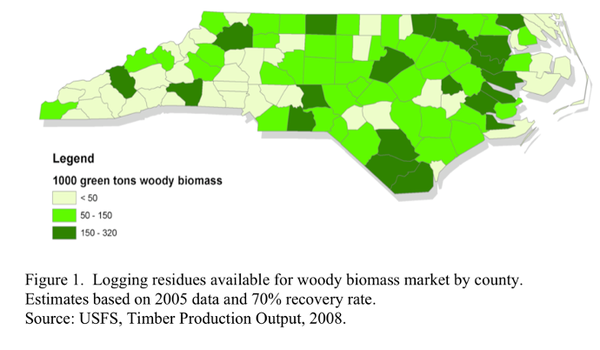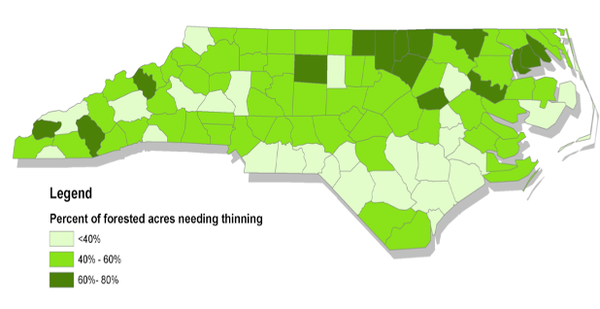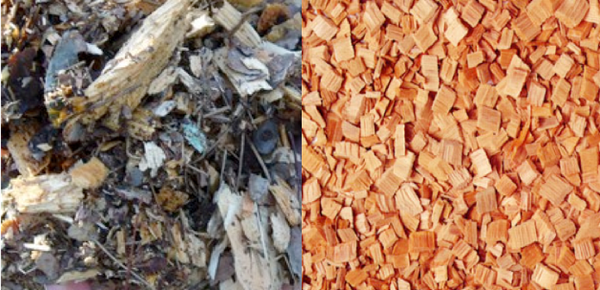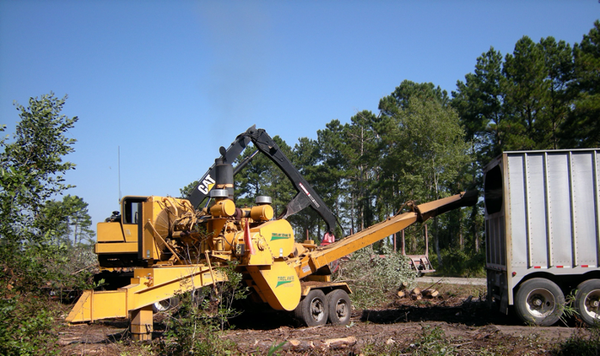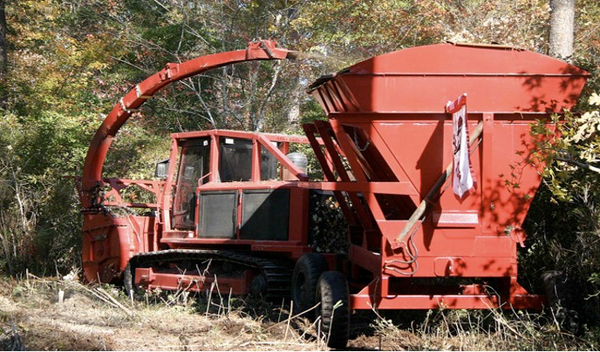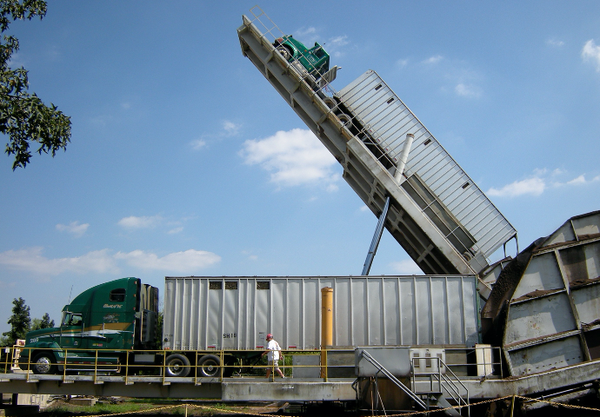Economics of Harvesting Woody Biomass in North Carolina
North Carolina has an estimated 7.3 million green tons of sustainably harvestable woody biomass feedstock solely from logging residues1. While the 18.1 million acres of timberland in North Carolina are full of woody biomass ready for harvest, the cost of harvesting and transportation to markets make it a low value material. This publication reviews the basic steps and cost factors associated with woody biomass harvest, processing and transportation. This provides landowners with the basic technology and general economics of biomass production in North Carolina and currently available forest management options.
Biomass Supply Potential in North Carolina
Woody biomass can be easily supplied to facilities through sustainable forestry practices such as timber harvesting and intermediate thinning operations. Currently, the most common practice of woody biomass harvesting is during conventional timber harvesting. According to the 2015 US Forest Service TPO survey, timber products harvesting in North Carolina generated roughly 7.3 million tons of logging residues (or “logging slash”) annually. Most of this logging (and hence, most of the logging residues) occurs in the eastern half of the state (Figure 1).
Other large sources of biomass potential are in “high-graded” and fully- or over-stocked stands that occur in the majority of the forested areas of North Carolina. In many cases the best alternative for high-graded stands is removal of the current timber and replanting a good species mix. Fully- and over-stocked stands are stands that need thinning operations to benefit the health and vitality of the forest. Many acres of timber are in need of thinning to reduce risk of hazard and increase productivity (Figure 2).
Also, when logging does occur, leaving large amounts of logging residues on site creates fire hazard and site preparation problems. Without a biomass market, there is no or very little economic incentive for the forest landowners to perform these important practices. This results in lower site productivity and health of the forest. However, woody biomass-based facilities led by wood pellets mills increase demand for such low-valued woody resources. For forest landowners, this translates into better forest management such as thinning, site preparation, hazard reduction, and stand replacement opportunities.
Biomass Harvesting Economics
Simply put, a biomass harvester’s profit is determined by the difference between what is paid at the mill or plant (delivered price) minus the costs paid to the landowner for the trees (stumpage cost) plus harvesting and hauling costs :
Profit = Delivered Price – Stumpage Cost - harvest cost - transportation cost
Now, consider the following scenario to chip a one-truck payload of 25 green tons (20 minutes at $125.00 / hr) and deliver it biomass to a facility 50 miles away (at $4.00 / mile). The facility pays a delivered price of $18.00 per green ton2:
| Per load | Per green ton | |
| Delivered price | $500 | $18/ton |
| Transportation costs | $200 | $8/ton |
| Harveting costs | $42 | $1.68/ton |
Profit (per ton) = $18.00 – Stumpage Cost - $1.68 - $8.00
This leaves $8.32 / ton, not much for profit for the logger. Therefore current markets do not allow logger to pay much (if anything) for biomass. Until profits reach proportions closer to pulpwood (Figure 3) we are not apt to see any business solely relying biomass harvesting.
Biomass Markets, Harvesting, and Processing
Because of the economics outlined above, woody biomass is currently a low value by- product of commercial timber harvesting. In the Southeast, standard mechanized harvesting equipment such as feller-bunchers and grapple skidders are used to cut and haul the commercial timber. Small, poorly formed and otherwise un-merchantable trees, tops and branches are hauled to the landing as well and sorted. (Note: see “Combining biomass harvesting with conventional timber harvests” at the end of this document for pros and cons.)
What happens next is determined by two possible woody biomass markets available to the logger. Energy-producing firms that simply burn the biomass and some liquid energy plants (such as ethanol production) will purchase “dirty” chips or “hogged” fuels (Figure 4). These are chips or ground material with the leaves and bark included. Loggers selling to this market purchase a chipper and chips vans to process and transport tops, branches, and small trees (Figure 5). Some chipping machines have the ability to remove the lighter leaves and smaller material to keep nutrients on- site. The price for dirty chips reflects the fact that it is the lowest value material from the timber harvest.
Pellet mills and certain liquid energy plants require “clean” chips (chips with no bark or leaves, Figure 4). These facilities directly compete with pulpmills and oriented strand board mills (OSB) for small roundwood. Some of these facilities have their own debarking and chipping operations to meet their feedstock specifications. For these facilities, loggers simply deliver roundwood. Other clean chip facilities may only purchase processed chips. To sell to these facilities, loggers add debarking and chipping equipment, increasing the cost of their operation. As clean chip biomass facilities develop, higher demand (and price to some extent) for small diameter material will justify adding the extra equipment. This will lead to more loggers processing junk trees during traditional harvest, increasing thinning operations and even clearing high-graded timber stands for regeneration.
Another form of dirty chip woody biomass processing is “masticated” (chewed-up) trees and shrubs from land clearing operations, fuel reduction projects, and pre-commercial thinning operations. Research is under way to develop profitable methods for harvesting, processing,and loading unwanted woody vegetation (Figure 6). Higher demand for woody biomass can spawn new technologies providing opportunities for landowners to perform pre-commercial thinning and fuel reduction currently too expensive.
Woody Biomass Transportion
Trucking currently is the most common method of biomass transport in the North Carolina. If the facility accepts roundwood, then standard logging trucks are used. If chips are required, the facility’s receiving yard capability determines what type of chip van is necessary. Larger facilities have truck-tippers to empty from the van (Figure 7).
Any chip van can be emptied using these. Smaller facilities may not have tippers and can only accept “walking floor” chip vans that self-empty. These vans are more expensive and may be reflected in the delivery price to these facilities. Chip vans hold up to roughly 25 tons of green chips and can be loaded in 20 – 40 minutes depending on the chipper used.Developing markets may lead to centralized stockyards of chips near railroad lines or ports providing loggers more options for selling biomass.
Combining Biomass Harvesting With Conventional Timber Harvest Systems
| Advantanges | Disadvantanges |
|---|---|
|
Harvesting woody biomass for energy generates additional income for forest landowners |
Capital cost of conventional timber harvesting systems requires higher volume and large tracts to remain profitable. |
|
Conventional harvesting methods provide cost savings for subsequent silvicultural and site preparatory activities.
|
Higher harvesting / transportation costs for biomass keep the stumpage (payment to landowners) prices lower ($0/ton - $4/ton). |
|
Conventional timber harvesting methods require few, if any, modifications to their current system to accommodate biomass harvesting and hauling activities.
|
|
| Highly mechanized timber harvesting equipment, where the operator is off the ground in a cab, is generally safer. |
Summary
Currently, loggers work for the slim profit margin for harvesting and hauling biomass feedstock. This means two things for the woodland owner. First, it means that most loggers today do not work into biomass chipping. Most of the loggers continue to perform traditional logging and add a chipper or a debarker/chipper and chip trailers to their equipment mix. In doing so, they take advantage of the efficiency of their existing harvesting, skidding, and loading equipment, making it pay through higher prices for sawtimber and/or pulpwood. This could change when smaller, low-cost harvesting equipment becomes more available in the future.
Second, it means that the price for woody biomass offered by the logger will remain lower relative to other forest products. The good news is, considering the cost savings of site preparation and stand improvement through increased health and productivity, this is an additional economic opportunity for a woodland owner. In essence, biomass markets make good forest management practices affordable. Wood pellet and advanced biofuel facilities development specifically in Coastal Plains have profited woodland owners through better timber markets, forest health, and productivity. As more markets open throughout the state, demand increases and travel distances shorten, making this an attractive option for loggers and will open more options for woodland owners. As with all forestry operations, when implemented, biomass harvesting must be based on sound forest management objectives.
End Notes
- Logging residues are defined as slash, tops, limbs and other woody materials left after conventional forest products are harvested, sorted, and removed in a logging operation.
- Notes on weights and prices:
- Green ton prices are based of freshly chipped material. Dry ton prices are roughly 2 times green ton prices as the dry weight is roughly one half the green weight.
- The example is based on current “dirty” green chip price averages as of publication date. “Clean” chip facilities pay closer to pulpwood prices.
- Demand and subsidy programs could change allow for higher delivery prices. For example, June 2009 passage of the Biofuels Crop Assistance Program (BCAP) essentially doubles the delivered price a registered facility can for biomass.
Publication date: Jan. 1, 2009
Reviewed/Revised: Aug. 19, 2020
N.C. Cooperative Extension prohibits discrimination and harassment regardless of age, color, disability, family and marital status, gender identity, national origin, political beliefs, race, religion, sex (including pregnancy), sexual orientation and veteran status.

